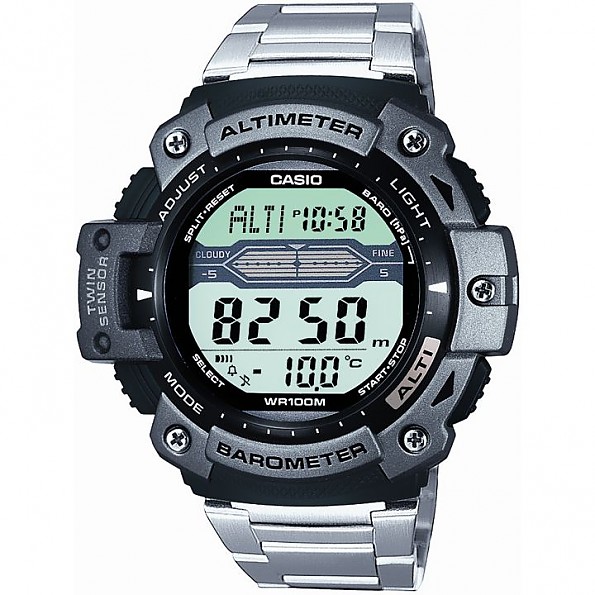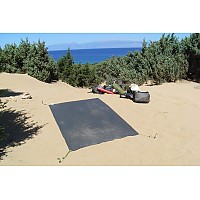Casio 3202 Twin Sensor Watch

A reliable multi-function watch, with altimeter, at an excellent price point.
Pros
- Fairly accurate, good altimeter and barometer
- Solid and reliable
- Inexpensive
- Lots of functions
Cons
- Thermometer not reliable
- Perhaps too many unnecessary functions
For a few years, I've been looking for an all-in-one watch that would include an altimeter and barometer, but the $200-500 price tag for a Suunto or St. Moritz was too steep for my tastes.
Then a couple of years ago, Casio came out with two new watch designs at a much lower price point. In addition to the standard features on many digital watches (alarms, time zones, stop watches) one included a digital compass ($65) and the other came with an altimeter/barometer function ($75). It would have been nice to have both, but I'm used to my old compasses anyway.
I was impressed with the design; stainless steel wristband, solid raised bezel, well-protected three-button selection, and operational details like a backlight. I had the watch sized for my wrist at the store, and I found it comfortable to wear from then on.
Then I started reading the manual!
The English section of the manual is 77 pages — granted, they are very small pages, but that's a lot of stuff to absorb. It took a while to get it all set up and get a basic understanding of how to use it, including maybe half an hour to get everything properly calibrated. Set home city time zone, daylight savings timekeeping mode, read about calibrating the barometer and altimeter, getting the temperature, selecting metric or SAE units, setting the 5 daily alarms and using the stopwatch and countdown timer. Lots more options (like turning the button sounds off and on) but nothing that important if you just want to get going.
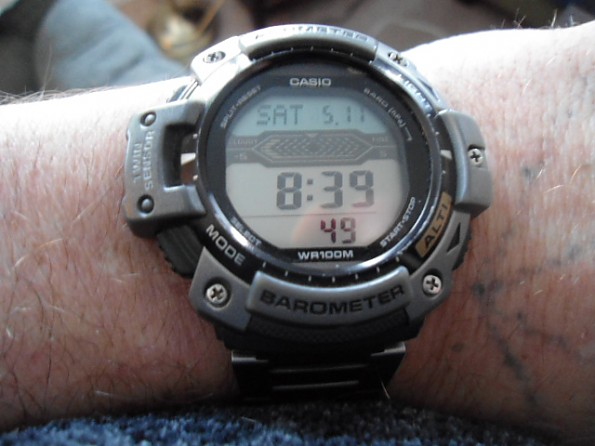
The basic display includes day and date at the top, time in hours and minutes, and seconds at the bottom. In whatever other function you're using, the time and function will still be displayed in the top bar. While I occasionally find myself thinking the time is 12:20 PM because I'm confusing altitude with time, I usually get that sorted out fairly quickly. It also displays temperature in the lower section, but that can be ignored (more on that later).
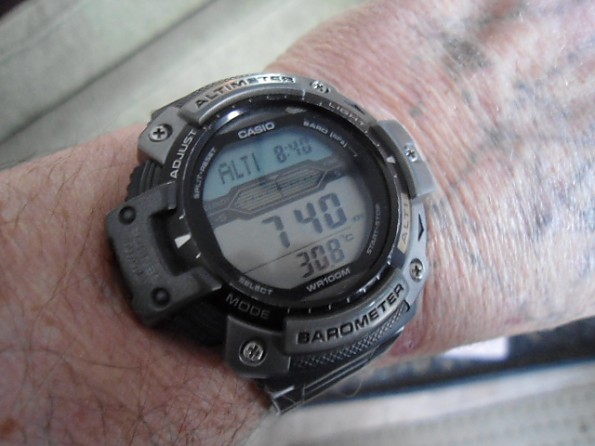
In actual use, you have to remember that, unlike a GPS system with elevation data, the watch relies on atmospheric pressure to give accurate readings for the barometer and the altimeter. Since that changes constantly as the weather fronts move in and out (generally high=clearing and low=rain) that means that before starting a hike, you have to know your starting elevation, and you have to calibrate the altimeter to that point. The pressure (and hence the altimeter reading) may change a bit over the course of a day, but usually not by very much. The Casio bases its altitude measurements on International Standard Atmosphere values stipulated by the International Civil Aviation Organization. These take into account the interaction between air pressure, temperature and altitude.
Most good trail maps (Gemtreks and other topos) show the elevation at the trailhead, so that's not usually a problem as long as you remember to set it at the start. On the other hand, I am usually more interested in elevation gain, rather than actual elevation, so I found I would sometimes just round out the starting point to perhaps 1,000 metres (Jasper townsite) and go from there. If I know the summit is 2,500 metres higher, for example, at least I know how much more climbing I have to do. For more serious ascents, I'll be more meticulous, but for general purpose hiking that's more than good enough. Accuracy of the altimeter function is ±5 metres (20 ft) so you get a pretty good idea of how high you are.

The range of the barometer is given as 260 to 1,100 hPa (or 7.65 to 32.45 inHg) displayed in 1 hPa or 0.05 inHg increments, and temperature displays as degrees Celsius or Fahrenheit with a ±2°C accuracy. In barometer mode, there also a pressure differential arrow showing the trend, whether towards high or low pressure which give a fairly good indication of what's coming in.
Probably the biggest flaw in the whole system is the thermometer — since the sensor is on your wrist, it reads the temperature there, not what the ambient temperature is around you. For a while, I tried setting it every time so that it would show the outside temperature (allowing for body heat), but eventually just gave it up as lost cause. Putting on gloves if it's cold outside warms up your wrist, and a cool breeze will chill the sensor, too.
One interesting note; setting the temperature control for the factory default gives me a temperature on my wrist of 30°C, when I know the ambient is 21°C. It is suggested that if temperature is the most important information needed to hang the watch off your pack, but if altitude is more critical, to wear it on your wrist.
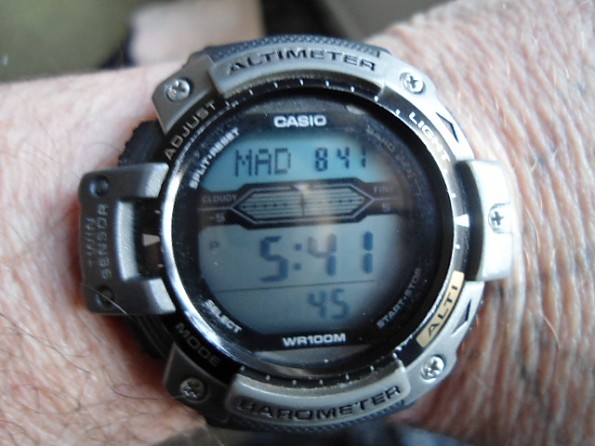
Most people will be familiar multiple time zones offered on modern digital watches. Using standard airport abbreviations, like LAX, NYC or YVR, the watch lets you find times in other parts of the world. The Daylight Savings Time for that city is also set in this mode.

The stopwatch and countdown timers are equally familiar; one button to start, another to stop and a third to reset. Calibration is in hundreds of a second for the stopwatch and 1 second increments for the countdown timer.
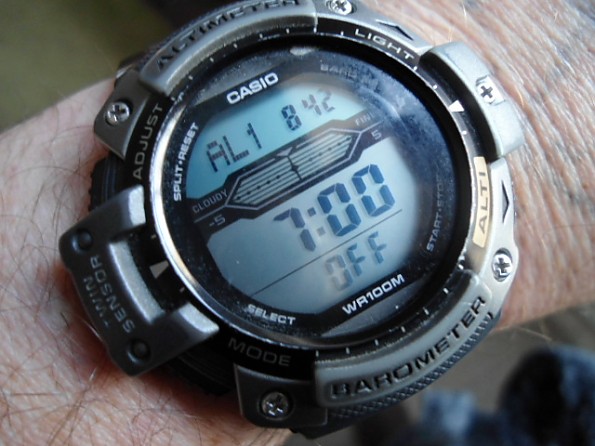
The alarms are similar – pick the one you want, and set it to go off or not. Watch out for the ones you set then forget about – I've had the unpleasant experience of being woken up for a 4:00AM alpine start a day later because I forgot to clear the alarm!
The Casio Twin Sensor has a lot of functions, some of which will be valuable, and some of which you might find you never use. I've never used the stopwatch or countdown timer, and have only rarely used the world times function. The watch is complicated by the extras (which may be because I only pull it out for mountain trips). In fact, I find that after a couple of years, I still have to keep referring to the manual every time I pull it out.
That being said, the bottom line is that I've been using it for a few years, now, on mountain trails throughout the Canadian Rockies, under a wide variety of conditions from hot summer days to winter snowshoe trips, and at elevations up to perhaps 2,500 metres. When guiding a group, I need something to give them bragging rights, as well as to answer the age-old questions 'Are we there yet?' or 'How much farther is it?'. It's worked just fine, and I have no plans to replace it with something else.
All in all, good value for the money. I can live with the shortcomings and the watch has done the jobs I wanted it to do. It's comfortable, reliable, and (other than the temperature) seems to be pretty accurate.
Technical information:
-
1 lithium battery, type CR2016, lifespan 3 years
-
Accuracy: ± 30 sec per month
-
Time keeping: 12 or 24 hour modes, hours, seconds, hundredth of a second (stopwatch)
-
Altimeter range: -700 to +10,000 metres (-2300 to +32,800 ft), display range -10,000 to +10,000 metres
-
Barometer range: 260 to 1,100 hPa (or 7.65 to 32.45 inHg) displayed in 1 hPa or 0.05 inHg increments
-
Thermometer range: -10°C to 60.0° C (14 to 10 °F), ±2°C/0.2°F
Source: bought it new
Price Paid: $75
Works fine. Very happy with it.
Pros
- Inexpensive
- Does the job
Cons
- Manual is super small type

I just needed an altimeter watch for whiteouts in the winter while hiking. I've been using it in weather around 15–35ºF so far and it works fine. Very happy with it. Had it for about a month.
The manual is a problem to read, but I solved that by downloading the PDF version from the Internet and enlarging it on my desktop. Done that way, it is easy to figure out.
Source: bought it new
Price Paid: $38
I am totally satisfied using this watch. It is most advance technology available in very cheap price. All-in-one model, just like a watch but but many specifications included in this watch.
Pros
- So good
Manufacturing quality was very rigid. Look so nice, silver plated straps dial is entirely different color combination.
Source: received it as a personal gift
I purchased two of this watch.
Pros
- Had one for years—reliable
Cons
- Battery hard to replace
Had this model for 8 years till a jeweler replaced the battery then this watch failed, so I purchased another on Amazon.
The barometer did not work so Amazon sent a second watch. This watch has the same problem, no barometer arrowhead.
Background
Had one for 8 years.
Source: bought it new
Price Paid: $57
F-ed up instructions.
Pros
- None
Cons
- All
Impossible to read the manual, and it does not make sense nor does the setup work. Total piece of sh*t.
Background
Anything is better than this, even a sun dial.
Source: bought it new


